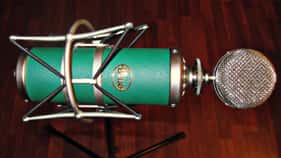
Signal Chain Hierarchy – Part 2: Drumkit Microphones
Last week in my series on the recording chain hierarchy, we talked about the source being paramount. If you don’t have a good sounding source, you won’t have a good sounding recording. Next in the hierarchy, in my opinion, is the microphone. Drumkit microphones are like the ear through which you hear the source being recorded.
Each microphone has different characteristics – places in the frequency spectrum that the electronics enhance or attenuate. When looking to creatively capture your source, I feel the microphone makes more of a difference than the pre or the converters. In terms of the signal chain hierarchy, each successive stage in the chain can only enhance or subtract from the stage before it, but not replace it. For example, you have a snare drum tuned to a low thud with rattly snares. The microphone choice will not be able to remove the rattle of the snares nor make the snare sound like a tightly tuned piccolo. The microphone can make the snare sound more fat or thin, bright or dark, snappy or slushy.
This being the case, you can select drumkit microphones in one of two ways: 1) the microphone that most clearly captures the source drum without adding or subtracting anything – the “purist” approach; 2) the microphone that most significantly colors or changes the sound of the source – the “tweaker” approach. The purist approach looks for the least interference from source to disk. The tweaker approach starts with a sonic target in mind and tries to conform the source at hand to this target.
Let’s listen to some examples of how different microphones “hear” a kick, snare, hat combo. Each example was recorded through the same preamp at the same approximate level. Great effort was made to place each microphone in the same place. As the picture on the left shows, the microphone was placed behind the kit, at waist height, pointing downward toward the kick and the snare.
Shure SM7b
This mic seems to really emphasize the snare. Listen again after checking out the other mics. It makes things sound rather snappy. I feel it is the most true to the source.
Sennheiser 421
This mic emphasizes the kick and the hi hat. The kick has a pleasant hi end and point to the attack.
Royer 122
This mic also emphasizes the kick but the high end is much less exaggerated than the 421 (because the mic is a ribbon mic – darker by nature). It sounds good and fluffy. Note also that since this mic is bi-directional, there is a bit more room in the sound.
Neumann U-87 Ai
This mic also emphasizes a bit of the low end, but overall the mic is noticeably more strong in the midrange. Listen to the ring of the snare and how this mic pulls it out.
Listening to the examples, I hope you hear how each mic changes the way the source is heard. At the same time, as per my proposed signal chain hierarchy, none of the mics effectively change the source from being a small kick, a medium-low tuned snare, and a light set of hi hats. First the source, then the drumkit microphones. Next week we’ll talk about preamps.


